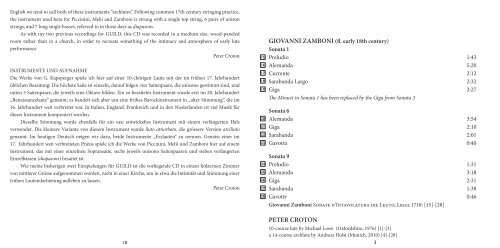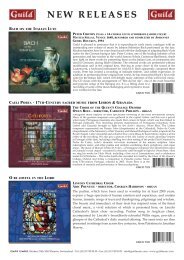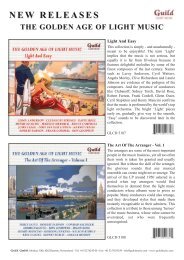PETER CROTON with Archlute
PETER CROTON with Archlute
PETER CROTON with Archlute
You also want an ePaper? Increase the reach of your titles
YUMPU automatically turns print PDFs into web optimized ePapers that Google loves.
English we tend to call both of these instruments “archlutes”. Following common 17th century stringing practice,<br />
the instrument used here for Piccinini, Melii and Zamboni is strung <strong>with</strong> a single top string, 6 pairs of unison<br />
strings, and 7 long single basses, referred to in those days as diapasons.<br />
As <strong>with</strong> my two previous recordings for GUILD, this CD was recorded in a medium size, wood-paneled<br />
room rather than in a church, in order to recreate something of the intimacy and atmosphere of early lute<br />
performance.<br />
Peter Croton<br />
INSTRUMENTE UND AUFNAHME<br />
Die Werke von G. Kapsperger spiele ich hier auf einer 10-chörigen Laute mit der im frühen 17. Jahrhundert<br />
üblichen Besaitung: Die höchste Saite ist einzeln, darauf folgen vier Saitenpaare, die unisono gestimmt sind, und<br />
unten 5 Saitenpaare, die jeweils eine Oktave bilden. Ein so besaitetes Instrument wurde erst im 20. Jahrhundert<br />
„Renaissancelaute” genannt; es handelt sich aber um eine frühes Barockinstrument in „alter Stimmung”, die im<br />
16. Jahrhundert weit verbreitet war. In Italien, England, Frankreich und in den Niederlanden ist viel Musik für<br />
dieses Instrument komponiert worden.<br />
Dieselbe Stimmung wurde ebenfalls für ein neu entwickeltes Instrument mit einem verlängerten Hals<br />
verwendet. Die kleinere Variante von diesem Instrument wurde liuto attiorbato, die grössere Version arciliuto<br />
genannt. Im heutigen Deutsch neigen wir dazu, beide Instrumente „Erzlauten“ zu nennen. Gemäss einer im<br />
17. Jahrhundert weit verbreiteten Praxis spiele ich die Werke von Piccinini, Melii und Zamboni hier auf einem<br />
Instrument, das mit einer einzelnen Sopransaite, sechs jeweils unisono Saitenpaaren und sieben verlängerten<br />
Einzelbässen (diapasons) besaitet ist.<br />
Wie meine bisherigen zwei Einspielungen für GUILD ist die vorliegende CD in einem hölzernen Zimmer<br />
von mittlerer Grösse aufgenommen worden, nicht in einer Kirche, um in etwa die Intimität und Stimmung einer<br />
frühen Lautendarbietung aufleben zu lassen.<br />
Peter Croton<br />
10<br />
15<br />
16<br />
17<br />
18<br />
19<br />
20<br />
21<br />
22<br />
23<br />
24<br />
25<br />
26<br />
27<br />
28<br />
GIOVANNI ZAMBONI (fl. early 18th century)<br />
Sonata 1<br />
Preludio 1:43<br />
Alemanda 5:20<br />
Currente 2:12<br />
Sarabanda Largo 2:32<br />
Giga 2:27<br />
The Minuet in Sonata 1 has been replaced by the Giga from Sonata 3<br />
Sonata 6<br />
Alemanda 3:54<br />
Giga 2:10<br />
Sarabanda 2:01<br />
Gavotta 0:40<br />
Sonata 9<br />
Preludio 1:31<br />
Alemanda 3:18<br />
Giga 2:31<br />
Sarabanda 1:38<br />
Gavotte 0:46<br />
Giovanni Zamboni Sonate d’Intavolatura die Leuto, Lucca 1718: [15]-[28]<br />
<strong>PETER</strong> <strong>CROTON</strong><br />
10-course lute by Michael Lowe (Oxfordshire, 1976) [1]-[3]<br />
a 14-course archlute by Andreas Holst (Munich, 2010) [4]-[28]<br />
3
















